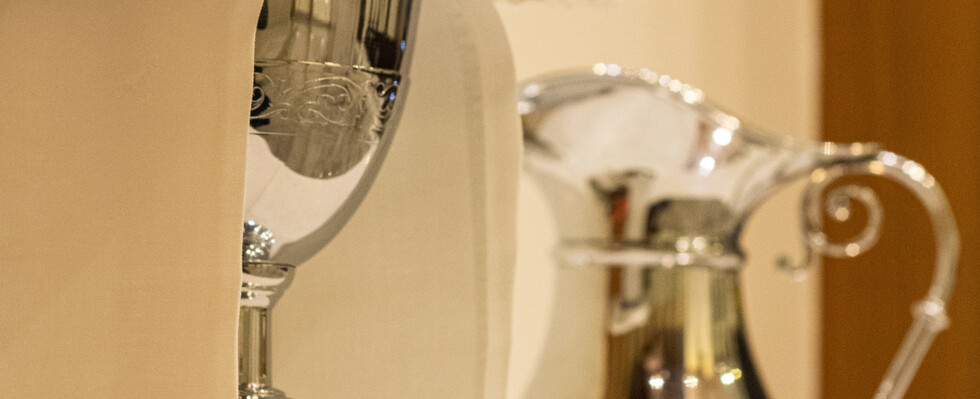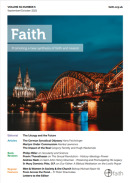The Liturgy and the Future
Pope Francis came in for a lot of criticism in his decision to restrict the use of the 1962 Missal in parishes.
In fact, the important part of his document came at the end: with a plea for a more reverent and worthy celebration of the ordinary Mass and a recognition that it is often the style of celebration of many ordinary Masses which can be so off-putting to the more traditionally-minded, and indeed to the ordinary devout Catholic. The problem goes back to when the new liturgy was introduced. It has still got with it much of the baggage of the popular culture of the 1960s and 70s: all must be casual and spontaneous, and anything formal or ritualistic is suspect. We need to shed this attitude. It has caused the loss of the sense of the sacred in so many parish Masses. A folksy style and banal or pop-like tunes are doing nothing to hold our young people, the majority of whom lapse in their early teens. When you’ve sat through many of these, you can see why traditionalists despair and opt for the older rite Mass.
‘New’ and ‘traditional’
But there is a deeper issue, too, which both sides of the liturgical divide need to take on board. In the 1970s the ‘new Mass’ was presented as a revolutionary break. In the spirit of that age, old was bad and new was good, and the new liturgy was presented as something which had just been made up. There was, deliberately one fears, no sense of historical continuity. This played into the traditionalist narrative that the 1962 liturgy was ‘the Mass of the Ages’. It is not, of course. It is not the Mass of the Apostolic Age, nor of the Patristic age. It is the Mass of the early Middle Ages, which was then frozen by 1960s may not have got everything right, but the Council was aiming to ensure a link with the classic Patristic form. Pope St Pius V after the Council of Trent with all the accretions which it had acquired by that point.
Traditionalists who distrust anything written after Vatican II might like to read Adrian Fortescue’s The Mass: A Study of the Roman Liturgy, published in 1912. The liturgical reformers of the 1960s may not have got everything right, but the Council was aiming to ensure a link with the classic Patristic form. It was a noble aim and was the fruit of the preceding Liturgical Movement of the first half of the 20th century (which had inspired Pope Pius XII’s Holy Week reforms). It’s also worth reading St John Henry Newman’s historical novel Callista where he gives a description of Mass being celebrated in the 3rd century. It’s a lot more like a novus ordo Mass, with the active participation of the people, than a 1962 rite Mass today.
In sum, old rite devotees need to know more history, and the ordinary Mass needs to be celebrated with a greater sense of historical continuity. We must hope that this is being addressed in the training of our next gener- ation of priests. Solemn new rite celebrations in Latin (and English) are to be found in some churches today; the drift is in that direction.
Modern Donatism?
Pope Francis is not wrong in his concern about division in the Church. The tradition- alist mindset is one which is a temptation to good Catholics in every age - crises are not unique to modern times. In the early 4th century, the Church was faced with the after- math of the Diocletian persecution: many Christians, including clergy, had been terrified into betraying the Faith, agreeing to sacrifice to idols or handing over copies of the Scrip- tures to be burnt. Many of these lapsi now wanted to come back to the Faith. What was the Church to do? The answer was forgive- ness and, after due penance, readmission to Communion. But some of those who had remained faithful and had suffered as a result were outraged: such betrayal could never be forgiven, and sacraments celebrated by such lapsed priests could not be valid. These hard- liners refused to accept the Church’s policy of forgiveness and withdrew into a ‘church of the pure’ of their own. They were known as the Donatists and caused a great deal of trouble, especially in North Africa. St Augus- tine devoted much of his great intellect and energy to opposing them.
The Donatists saw themselves as defenders of tradition against the weak, indeed hereti- cal, Church authorities of their day. Ultra-tra- ditionalists today are in danger of falling into the same mindset, seeing themselves as the faithful remnant of a church which has gone astray. This is not a Catholic atti- tude. Newman realised he had to become a Catholic when he grasped the implications of St. Augustine’s saying which he had used against the Donatists, securus judicat orbis ter- rarum: the whole Church - not just one part of it - judges justly. The Mass promulgated by Pope St Paul VI, after Vatican II had decreed a reform of the liturgy, is the Mass celebrated throughout the world. Like all rites, it doubt- less isn’t perfect. But the old rite was not perfect either, and it is historical nonsense to canonise it as unchangeable. Newman voiced another important insight when he questioned whether mediaeval Gothic was the only right architecture for the modern age. ‘An obsolete discipline’, he observed, ‘may be a present heresy’.
The future
It was Newman, again, who pointed out that Councils have often been followed by periods of turbulence. It does not mean they should not have happened; and history cannot be ignored.
Pope Francis’s new ruling will have infuri- ated those who want only the old rite. But it would be wrong for them to start building up enclaves. We need young priests who will re-sacralise the celebration of the ordi- nary Mass. Catholicism is a popular religion, not a club for a liturgical elite. The ordinary Mass is the way that Our Lord comes to ordi- nary Catholics.
At the most extreme end, there are the Lefeb- vrists who are in effect a communion of their own, playing little or no part in mainstream Catholic life. But even some mainstream old rite followers will not receive Communion at an ordinary Mass. A few years ago, an old rite group who were using a Catholic institution for a summer conference even removed the Blessed Sacrament from the chapel’s taber- nacle because it had not been consecrated at an old rite Mass.
So, when Pope Francis explains that he is restricting the celebration of the old rite because it has become a threat to the unity of the church, he has a point. To be a Catholic is to be in communion with all other Catho- lics all over the world. If you refuse to receive Communion from a Mass which is celebrated in the rite used by the overwhelming majority of the worldwide church, in what sense are you really a Catholic?
Vatican II
Pope Francis puts his finger on the underlying reason why some old rite followers insist on their liturgy: it is a badge of hostility to Vatican II. However, it should be said that – except among some ultra-traditionalists – this does not always mean disagreement with the actual documents of the Council. Liturgical conservatism is largely a reaction to very badly celebrated ordinary Masses, with pop- style banal music or sermons which avoid doctrine. Going to the ‘traditional’ Mass is also a way of distancing oneself in general from the collapse of the Church in the Western world in the post-conciliar years.
This is very understandable, and the rest of us must be sensitive to it. For years there was a refusal by many Church authorities to admit that anything went wrong after the Council. The clergy abuse crisis has changed that. We now know just how sexually corrupt some of our priests – even some high-ranking and influential churchmen – have been in the post-conciliar years. There had been clerical abusers long before Vatican II of course, but the statistics show a marked spike in cases in the late 1960s and the 1970s. Traditionalist Catholics have fastened on the reform of the liturgy as the cause of the whole post-concil- iar crisis, but that is the fallacy of confusing post hoc with propter hoc. For instance, it would be very neat if all offending clergy were liturgical liberals, and no priest who said the old rite ever committed abuse, but that is not the case. And it is evident from history that the old rite did not prevent clergy corruption and abuse in other centuries.
The real reasons for the crisis are theological and philosophical. FAITH magazine has long argued that the church has not yet faced up to the intellectual challenge of the scientific evolutionary worldview. There has been a failure to present Catholicism to the con- temporary mind. So, we have never seen the liturgy as the key issue. The Faith Move- ment’s founder, Fr Edward Holloway, used to remind critics of poor post-conciliar liturgy that the old rite had sometimes been very badly celebrated too. He saw the catecheti- cal opportunity that vernacular liturgy gives, particularly valuing Eucharistic Prayer IV with its salvation history narrative. But he trenchantly criticised liturgical abuses which were based on unorthodox eucharistic the- ology, and FAITH’s approach has been that if the theology is sound, so will the liturgical celebration be. One could say lex credendi, lex orandi. It is significant – and disturbing – that the old rite ‘package’ can now sometimes include anti-intellectual and anti-scientific atti- tudes. There are traditionalist Catholics who have adopted fundamentalist beliefs about Scripture, insisting on a literalist reading of the Book of Genesis and rejecting evolution. This is a Protestant approach to the Bible, not a Catholic one. It is an intellectual blind alley and is a very long way from the great marriage of faith and reason that produced Aquinas, Copernicus, Mendel, or Lemaître. Such issues are actually more fundamental to the future of Catholicism than the language or ceremonies of our liturgy.
The need
The urgent need is to encourage celebrations of the ordinary rite – in Latin or in English – pos- sibly ad orientem, accompanied by plainchant or other traditional sacred music if possi- ble, and without the egregious weaknesses of contemporary liturgy such as lengthy off-the-cuff additions by the priest, or amateur rambling Bidding Prayers which promote fashionable causes. The mood among young clergy is in tune with this, the faithful need it, the evangelisation of our culture demands it






